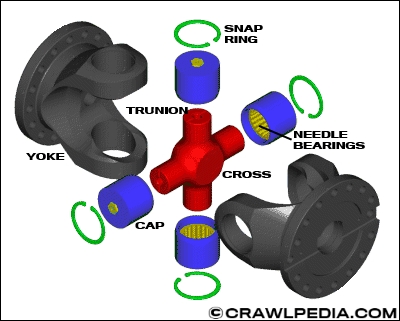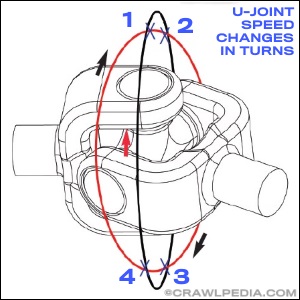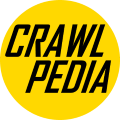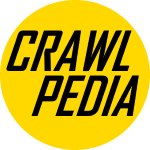U-Joints for Axles and Driveshaft
Universal joints, more commonly known as U-joints, are used in automotive driveshafts and front steer axles where rotational power needs to be transmitted between two misaligned shafts. They are comprised of a central cross with four trunions on which four sealed caps with internal needle bearings ride. The caps are held in place and within the yokes by snap rings.

Note: U-Joints are different from constant velocity "CV" joints used in IFS applications and should not be used for anything other than driveshafts and solid front axles where misalignment is low or intermittent.
U-Joint Angles and Binding

While u-joints are a simple way to transfer torque through an angle, they are far from perfect. Anything outside of a straight line will cause the yokes to bind, creating increased leverage forces on the u-joints and four speed changes during every rotation. These effects get more dramatic as the angle between the two shafts increases meaning that steering axles are at their weakest and most off-balance position when they are at full-turn.
| U-Joint Angle | Load Increase | Load Factor | Strength |
|
| 0 ° | 0.0% | 1.00 X | Strongest (100%) |
| 10 ° | 1.7% | 1.02 X | |
| 20 ° | 6.4% | 1.06 X | |
| 30 ° | 15.9% | 1.16 X | |
| 40 ° | 30.8% | 1.31 X | Weakest (70%) |
Constant Velocity Joints
Constant velocity or "CV" joints eliminate binding and speed changes during rotation, however, they are more expensive and mainly used in independent suspension vehicles and some Toyota and Mercedes straight axles. Driveshafts with properly phased u-joints with matching input and output angles will also have constant input and output speeds because the misalignment angles cancel themselves out.
Front Axle U-Joints (Wheel Joints)
Standard OEM Steering Axle U-Joints
Universal joints found in front steering axles of 4x4 vehicles have different requirements than those used in driveshafts since they are mounted directly at the wheel and see high torque loads, higher angels, and are more exposed to mud, water, and debris.
While most OEM u-joints will last the life of a typical 4x4 truck or SUV, modifications like larger tires and increased horsepower combined with extreme use will cause them to wear out faster.
Although there are hundreds of different u-joint sizes, steering axles typically only use 1310 and 1480 series wheel joints with newer commercial truck axles using extra-large 1550 series joints. Steering axle joints also tend to have inner snap rings (ISR) as opposed to outside snap rings (OSR) used in most driveshafts. The following table contains a list common steering axle u-joints:
| Model | Series | Snap Ring Spread | Cap Dia. | Greaseable | Applications |
|
| 5-260X ⤴ | 1310WJ | 2.188" (Inside) | 1.062" | No | Early "Small" Dana 30 Axles |
| 5-760X ⤴ | 1310WJ | 2.188" (Inside) | 1.188" | No | Dana 30 & 44, GM 8.5 Axles |
|
| SPL55-3X ⤴ | 1480WJ | 3.000" (Inside) | 1.375" | No | Dana 60 Axles |
| SPL55-4X ⤴ | 1480WJ | 3.000" (Inside) | 1.375" | Yes (Body) | Dana 60 Axles |
|
| 5006813 ⤴ | 1485WJ | 2.90" (Inside) | 1.375" | No | AAM 9.25" IFS Axles |
|
| SPL70-4X ⤴ | 1550WJ | 3.78" (Inside) | 1.375" | Yes (Body) | Dana Super 60, 70, 80 |
|
| CP750N | 750N | 4.747" (Outside) | 1.626" | Yes (Body) | Rockwell 2.5 Ton |
As an Amazon Associate, we earn a small commission on purchases which does not affect your pricing.
U-Joint Width vs. Cap Size
U-Joint sizes change based on two factors, the overall width of the cross and the diameter of the caps. Larger caps result in a stronger joint, while a larger cross will usually allow for more misalignment. For example, both 1310 and 1330 U-joints use 1.062" diameter caps, however, the 1330 is .406" wider and allows for more misalignment.
Axle U-Joint Strength Ratings
U-joint strength depends on the type of steel it is made from as well as the size of the body, bearings, and caps. They are rated by continuous torque loads which are calculated based on the full expected life of the u-joint. Catastrophic failure ratings are estimated to be 2 to 3 times listed yield torque.
| U-Joint Series | Max Angle | Continuous Tq. | Max. Cont. Tq. | Yield Tq. |
|
| 1310WJ | 27-30 Deg. | 130 lbs-ft. | 790 lbs-ft. | 1,600 lbs-ft |
| 1480WJ | 35-38 Deg. | 340 lbs-ft. | 2,000 lbs-ft. | 3,300 lbs-ft |
| 1550WJ | 45-50 Deg. | N/A | N/A | N/A |
|
|
Note: Angles are measured as total turn, left to right. Steering angles are often limited by yokes and knuckles which may be modified for additional clearance.
|
Competition U-Joints
In extreme applications where axles are fitted with aftermarket 4340 Chromoly or 300M alloy axle shafts, standard u-joints would be an unwanted weak link. Companies like Yukon, OX, and CTM make extra strong, race-only style u-joints that can handle big tires and horsepower, however, these joints typically require daily lubrication and servicing that make them impractical for everyday use.

RCV Chromoly CV Axle Shafts
While competition u-joints do provide great strength, they still have the same u-joint faults listed above. To get the ultimate in strength and reliability, u-joints need to be replaced with heavy duty constant velocity (CV) shafts. RCV 4340 Chromoly and 300M CV axle shafts are twice as strong as standard u-joint axles while providing constant input and output speeds all the way up to 45 degrees. They are so strong, in fact, that RCV backs them with a limited lifetime warranty that even covers oversize tires and high horsepower in race applications.
Driveshaft U-Joints
Standard OEM Driveshaft U-Joints
Driveshaft U-joints come in hundreds of different variations, however, the following six sizes are by far the most common.
| Series | Max Angle | Max Speed | Continuous Tq. | Max. Cont. Tq. | Yield Tq. |
|
| 1210 | | | 90 lbs-ft. | 560 lbs-ft. | 1,250 lbs-ft |
| 1310 | 30 ° | 6,000 RPM | 130 lbs-ft. | 800 lbs-ft. | 1,600 lbs-ft |
| 1330 | 20 ° | 5,000 RPM | 150 lbs-ft. | 890 lbs-ft. | 1,850 lbs-ft |
| 1350 | 20 ° | 5,000 RPM | 210 lbs-ft. | 1,240 lbs-ft. | 2,260 lbs-ft |
| 1410 | 35-37 ° | 5,000 RPM | 250 lbs-ft. | 1,500 lbs-ft. | 2,700 lbs-ft |
| 1480 | | 5,000 RPM | 340 lbs-ft. | 2,200 lbs-ft. | 3,300 lbs-ft |

U-Joint Models and Part Numbers
Driveshaft U-Joint List
U-joint models and part numbers have mostly remained consistent over the years, however, many joints have been replaced due to slight improvements and thus there may be numerous designations for the same u-joint model. The table below contains a list of the most common automotive u-joints as well as their various other part numbers.
| Model | Series | Snap Ring Spread | Cap Dia. | Greaseable | Previous PNs |
|
| 5-110X ⤴ | 1000 | 1.500" (Inside) | 0.938" | No | |
| 5-103X ⤴ | 1000 | 1.500" (Inside) | 0.938" | Yes (Body) | |
| 5-170X ⤴ | 1000 | 1.500" (Inside) | 0.938" | Yes (Body) | |
| 5-170-1X ⤴/td> | 1000 | 1.500" (Inside) | 0.938" | Yes (Cap) | |
|
| 5-101X ⤴ | 1100 | 2.411" (Outside) | 0.938" | No | 5-102X |
| 5-105X | 1100 | 1.718" (Inside) | 1.000" | Yes (Body) | 5-100X |
|
| 5-443X ⤴ | 1200 | 2.438" (Outside) | 1.062" | Yes (Cap) | 5-315X |
| 5-554X | 1200 | 2.438" (Outside) | 1.062" | Yes (Cap) | |
|
| 5-1310X | 1310 | 3.219" (Outside) | 1.062" | No | 5-1201X |
| 5-153X ⤴ | 1310 | 3.219" (Outside) | 1.062" | Yes (Body) | 5-200X, 5-121X |
| 5-1310-1X | 1310 | 3.219" (Outside) | 1.062" | Yes (Cap) | 5-433-1X, 5-810X |
|
| 5-1330X ⤴ | 1330 | 3.625" (Outside) | 1.062" | No | 5-790X, 5-791X, 5-812X, 5-618X |
| 5-213X ⤴ | 1330 | 3.625" (Outside) | 1.062" | Yes (Body) | 5-1203X |
|
| 5-3615X | 1350 | 3.625" (Outside) | 1.188" | No | 5-447X, 5-617X, 5-800X, 5-799X |
| 5-1350X ⤴ | 1350 | 3.625" (Outside) | 1.188" | No | 5-447X, 5-617X, 5-800X, 5-799X |
|
| 5-3208X ⤴ | 1355 | 3.612" (Outside) | 1.188" | No | |
|
| 5-1410X ⤴ | 1410 | 4.188" (Outside) | 1.188" | No | 5-801X, 5-641X, SPL36-1X |
| 5-1410X ⤴ | 1410 | 4.188" (Outside) | 1.188" | Yes (Body) | 5-801X, 5-641X, SPL36-1X |
| 5-160X ⤴ | 1410 | 4.188" (Outside) | 1.188" | Yes (Body) | |
| 5-481X | 1410 | 4.188" (Outside) | 1.188" | Yes (Body) | |
|
| 5-3207X ⤴ | 1415 | 4.188" (Outside) | 1.375" | No | |
|
| SPL70X ⤴ | 1550 | 4.964" (Outside) | 1.375" | No | |
| SPL70-1X ⤴ | 1550 | 4.964" (Outside) | 1.375" | Yes (Body) | |
Axle U-Joint List
The table below contains a list of the most common wheel joints along with their previous and/or additional part numbers.
| Model | Series | Snap Ring Spread | Cap Dia. | Greaseable | Previous PNs |
|
| 5-260X ⤴ | 1310WJ | 2.188" (Inside) | 1.062" | No | 5-260-1X / 5-74X |
| 5-760X ⤴ | 1310WJ | 2.188" (Inside) | 1.188" | No | 5-997X |
| SPL55-3X ⤴ | 1480WJ | 3.000" (Inside) | 1.375" | No | 5-332X / 5-88X / 5-806X |
| SPL55-4X ⤴ | 1480WJ | 3.000" (Inside) | 1.375" | Yes (Body) | 5-807X |
| 5006813 ⤴ | 1485WJ | 2.90" (Inside) | 1.375" | No | |
| SPL70-4X ⤴ | 1550WJ | 3.78" (Inside) | 1.375" | Yes (Body) | |
| CP750N | 750N | 4.747" (Outside) | 1.626" | Yes (Body) | |
As an Amazon Associate, we earn a small commission on purchases which does not affect your pricing.
U-Joint Grease
When it comes to u-joint lubrication, there are two types of u-joints, greaseable and non-greaseable. Non-greaseable u-joints don't have any external grease fitting where grease can be added meaning they come preloaded with enough grease to last their expected service life. Greaseable u-joints feature an external grease fitting or "zerk" fittings where grease can be added. Greasing a u-joint provides two main benefits, it replaces old grease with new grease for improved lubrication and pushes out any water or contaminants that have worked their way in past the seal. It is recommended to grease u-joints every 10,000 miles or every other oil change.
To add grease to a u-joint you will need a Grease Gun and some high performance synthetic grease. We highly recommend Mobil 1 Synthetic Grease because it is NLGI Certified to provide excellent lubrication in a wide range of temperatures, including high heat, and is resistant to washing out.
This U-joint guide is ©Copyright Crawlpedia.com - Please provide a link back to this page when copying.
Data is accurate to the best of our knowledge and is offered as-is with no guarantee.
More Drivetrain Guides:
Differential Locker Comparison - A detailed comparison of popular lockers and differentials.
Gear Ratio Finder - A calculator to help you find your correct gear ratio for larger tires.
Gear Ratio Calculator - Calculate the gear ratio of unknown or unmarked gear sets.
Ring and Pinion Setup Specs - A guide to ring and pinion setup specifications for popular axles.
Thick Gears and Carrier Breaks - A detailed explanation of differential carrier breaks and "thick" ring and pinion gears.
3.55 and 4.10 Gears Variations - Learn why some gear ratios have variations between some axles and brands.
Filthy Motorsports
High performance off-road racing parts and professional shock tuning. Learn more at
FilthyMotorsports.com
Shock Service, LLC
Professional shock tuning and rebuilding services for King and ADS shocks. Learn more at
ShockService.com
Polar Cryogenics
Cryogenic treatment improves strength and longevity of gears, axle, and brakes. Learn more at
PolarCryogenics.com
Crown Race Gears
Race-spec ring and pinion gears for desert racing, rock bouncing, and rock crawling. Learn more at
RaceGears.com





